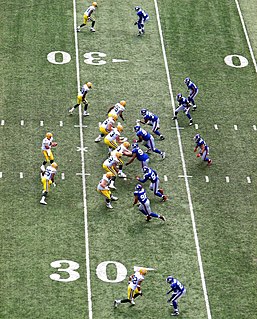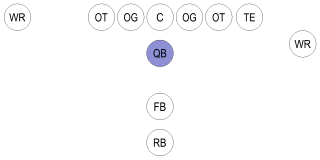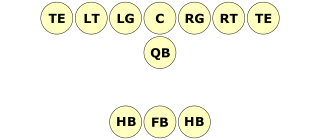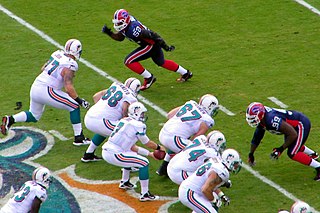The topic of this article may not meet Wikipedia's general notability guideline .(September 2010) (Learn how and when to remove this template message) |
Pistol-Flex or Pistol Double-Slot [1] is a hybrid of two well-known American football formations: Pistol and Flexbone formations. It was pioneered in 2009 by coach Paul Markowski who is currently an Offensive Consultant for Chestnut Hill College, Philadelphia, PA. [2] [3] By combining the strengths of each offensive set, the end result is a formation that is very effective both in the passing and running styles of play. The triple option can be used from this set very effectively. [4] Markowski has developed a true quadruple Option play run out of the Pistol-Flex formation.
The pistol offense is an American football formation and strategy developed by Michael Taylor and popularized by Chris Ault in 2005, while the latter was head coach at the University of Nevada, Reno. It is a hybrid of the traditional shotgun and single back offenses. In the pistol offense, also commonly referred to as the "pistol formation", the quarterback lines up four yards behind the center, which is much closer than the seven-yard setback in a traditional shotgun formation. The running back then lines up three yards directly behind the quarterback, which is in contrast to the shotgun, where they are beside each other. It is argued that the position of the quarterback in the pistol formation strikes an advantageous compromise: the quarterback is close enough to the line of scrimmage to be able to read the defense, as with run situation sets such as the I formation, but far enough back to give him extra time and a better vision of the field for passing plays, as in the shotgun. The pistol formation is thus very versatile, particularly if the quarterback himself is a threat to run the ball, which makes it difficult for the defense to correctly anticipate the play. This flexibility is enhanced by the Read Option, where the quarterback reacts to the response of the defensive players to the snap, and makes a rapid decision whether to hand off the ball to the running back, keep it and complete a pass to a downfield receiver, or keep it and run himself.
The base formation of the Pistol-Flex has the QB in a shotgun set four yards behind the center. The B-back is in a three-point stance with his down hand two yards behind the QB's feet. The two A-backs are set one yard directly behind the O-Tackle to their side. The offensive line splits are all 3 feet. There are multiple formations that the Pistol-Flex can be run from (Open, Tight, Bone, Box, Twins).

The shotgun formation is a formation used by the offensive team in American and Canadian football. This formation is used mainly for passing plays, although some teams use it as their base formation. In the shotgun, instead of the quarterback receiving the snap from center at the line of scrimmage, he stands farther behind the line of scrimmage, often five to seven yards back. Sometimes the quarterback will have a back on one or both sides before the snap, while other times he will be the lone player in the backfield with everyone spread out as receivers.

The three-point stance is a stance used by linemen and running backs in American football when ready for the start of a play. This stance requires one hand to touch the ground with the other arm cocked back to the thigh/hip region. The back should be slightly inclined forward, as well as the arm which is placed on the ground.
At any given time, there are at least four eligible receivers within one yard of the line of scrimmage which bodes well for the passing attack.

In American and Canadian football, a line of scrimmage is an imaginary transverse line beyond which a team cannot cross until the next play has begun. Its location is based on the spot where the ball is placed after the end of the most recent play and following the assessment of any penalty yards.









